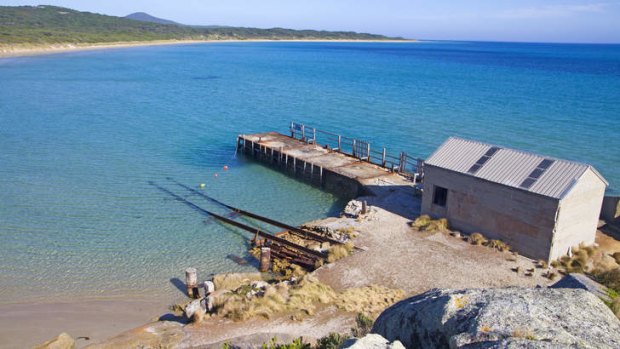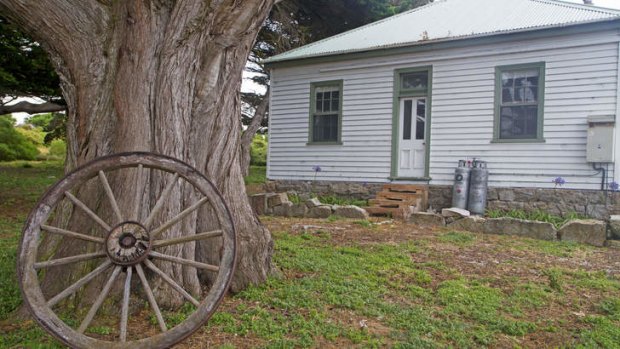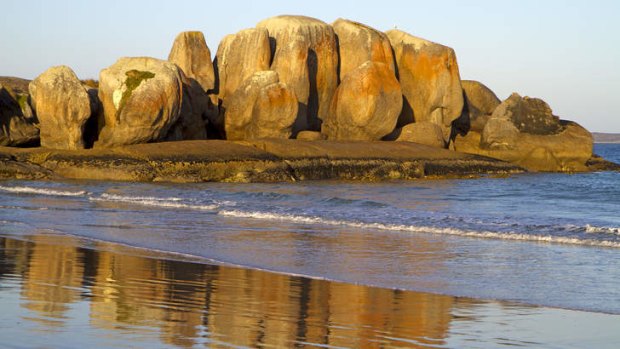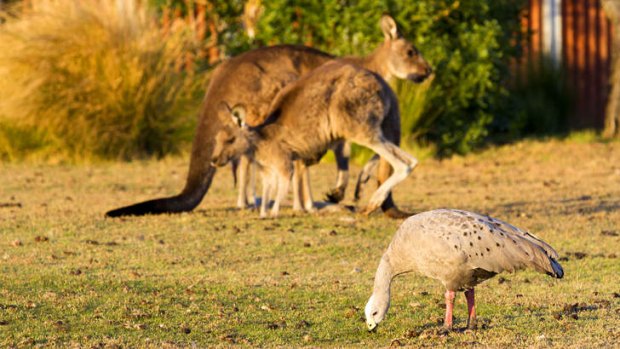
Three Hummock Island's jetty.Credit: Andrew Bain
A visit to this secret, Lilliput-like island can make you feel small, writes Andrew Bain.
When you fly into Three Hummock Island, airport safety procedures are a little unorthodox. As the plane banks over the granite-studded coast, the island's managers are driving around below, scattering the kangaroos and Cape Barren geese that graze the tiny airstrip.
Named for the three small hills that punctuate the island, and located between King Island and Tasmania's northwest tip, Three Hummock Island is a true castaway experience. An old farmstead clings to a point on its southwest corner, offering guest accommodation, and the only residents are its two managers, living among a crowd of wildlife.

The homestead on Three Hummock Island.Credit: Andrew Bain
The Southern Ocean stretches west all the way to South America from its shores, and if you stand on almost any of its headlands, enormous boulders tower overhead. It's the kind of place that can make you feel very small - perhaps even literally.
"This is Lilliput, you know," manager John O'Brien says. "In Gulliver's Travels, Lilliput is an island off the northwest tip of Tasmania and, if you look at the map in the book, it's shaped a bit like Three Hummock."
It's a doubtful claim, and one that's made half in jest, but it's certain Three Hummock Island inspired at least one other historical figure. In 1852 the Italian hero Giuseppe Garibaldi landed on the island, where he found an abandoned stone cottage and a vegetable garden.

The rock formation known as the Five Sisters on Spiers Bay.Credit: Andrew Bain
He was so captivated by the place that he decided to buy an island of his own - Caprera, offshore from Sardinia - as a retirement retreat.
"O desert island of the Hunter Group - how many times have you pleasantly excited my imagination," Garibaldi later wrote of Three Hummock Island. "When tired of this civilised society . . . I have often transported myself in my imagination into your gracious bosom."
Those words have a timeless quality because Three Hummock Island remains an enticing option for those "tired of this civilised society". Accessed only by private craft or charter flight from Burnie, it's a rare travel secret.

Cape Barren goose and kangaroos grazing the grasses around the homestead.Credit: Andrew Bain
From the airstrip I'm driven to the homestead, where I'll stay for two nights. Sleeping up to 12 people, it arrived on the island prefabricated in 1910 when its then-owner, Francis Grevis-James, was attempting to breed racehorses. For almost a century it served as a farmhouse before being turned into tourist accommodation in 2006.
Inside the homestead I'm like an exhibit in some inverse kind of zoo. Each dawn and dusk the building is surrounded by a mass of kangaroos and Cape Barren geese nibbling the lawns. One night I bump into a little penguin strolling past my front door.
A short walk from the homestead is the island jetty, where Three Hummock's first industry, boat construction, was based in the late 19th century. Sitting almost astride the line of the infamous Roaring 40s, however, the island has proved far more adept at wrecking ships.
Three Hummock is dotted with the scenes of stricken vessels - two of the buildings around the homestead were constructed using timber salvaged from wrecks - befitting its position in Bass Strait, but it's far from a place of fury.
Winds scour its impenetrable interior, but along the coast, which has about 30 beaches, there's always a protected cove somewhere. And it's the coast that is Three Hummock's star feature.
With its lichen-splashed granite headlands and empty beaches, the coast is reminiscent of the Bay of Fires. At high tide the sea swallows much of it, but at low tide the entire coast is ripe for exploration.
On my first evening on the island I wander out from the homestead and all but jostle my way across the airstrip, which is now crowded with kangaroos and geese. I'm heading for Spiers Bay, where a line of granite boulders known as the Five Sisters stands racked like toast across a headland.
As I step onto the beach, I discover that I'm not the only creature here to admire it. Beside me is a kangaroo.
"Sometimes you see the roos swimming," John says. "On hot days, or to get away from the March flies, they sometimes go in the water."
The Five Sisters are just one of many rock curiosities along the island's west coast. There are granite boulders eroded from within, giving them the appearance of eggshells and, as I walk north from Spiers Bay, rounding Burgess Point, the rocks at the ocean edge are dimpled like a golf ball. John and wife Beverley now collect the salt that gathers in these dimples, selling it to the likes of Hobart's Garagistes restaurant.
It's at the northern end of West Telegraph Beach, the island's longest beach, that I find what must surely be the island's true beauty spot.
Here, mounds of granite are so covered in lichen as to actually out-fire the Bay of Fires. A slab of rock is faintly scratched with an ancient Aboriginal petroglyph and the retreating tide has left behind translucent pools of water that are soon warmed by the sun. I lose much of a morning exploring among the boulders.
The island's dense interior opens up only on the track to South Hummock, one of the hills that earned the island its name from Matthew Flinders and George Bass in 1798. At 237 metres above sea level it's also the highest point among all of the Bass Strait's western islands.
On my final afternoon on the island I head to South Hummock with John and Beverley, who are happy to drive guests around. From the summit we see the view open out: islands queue across the ocean - Hunter Island, Albatross Island, the faint southeast edge of King Island - while far below is the homestead with its frame of postcard-perfect beaches.
"Keeping up the garden here is a lot of work," John says with a dry smile, waving his hand over 70 square kilometres of bush. It's indeed enough to make a person feel very small.
The writer travelled courtesy of Tourism Tasmania.
TRIP NOTES
MORE INFORMATION
GETTING THERE
Three Hummock Island is reached by charter flight from Burnie airport with Seair Adventure Charters. Phone (03) 6442 1220. Flight prices vary; phone to confirm.
STAYING THERE
Accommodation on the island is inside the homestead, which sleeps 12, or in a nearby cottage, which sleeps six. It costs $90 a person a night. The homestead and cottage are self-contained, and guests need to bring all food with them to the island. See threehummockisland.com.au.
FIVE MORE TASMANIAN ISLANDS
BRUNY ISLAND
Mix beaches and a nightly parade of penguins with local cheese, oysters and Australia's southernmost vineyard. See brunyisland.org.au.
KING ISLAND
Famed for its produce and also home to dramatic cliffs, a petrified forest and Australia's tallest lighthouse. See kingisland.org.au.
FLINDERS ISLAND
Mountains, wildlife and some of Tasmania's finest beaches. See visitflindersisland.com.au.
MARIA ISLAND
World Heritage-listed for its convict history, this national-park island has good walks, plentiful wildlife and the natural oddities of the Painted Cliffs and Fossil Cliffs. See parks.tas.gov.au.
SCHOUTEN ISLAND
Kayak along the Freycinet Peninsula coast to camp on this uninhabited island with a long whaling, mining and farming history and plenty of sheltered bays. See freycinetadventures.com.au.
Sign up for the Traveller Deals newsletter
Get exclusive travel deals delivered straight to your inbox. Sign up now.